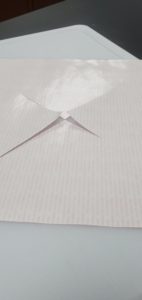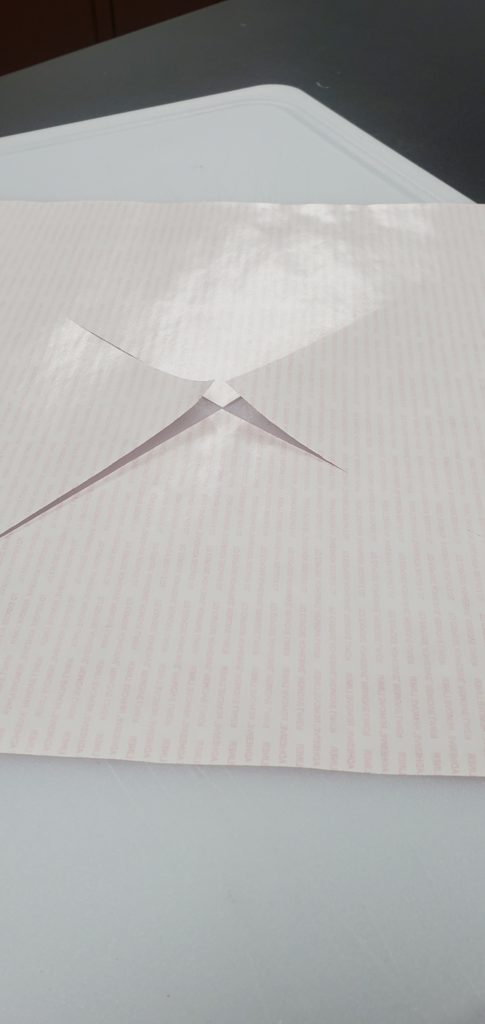Written by Tom Ray, Technical Director, Channeled Resources Group
What is Curl?
 When silicone is cured on paper, the heat from the dryer generally drives moisture out of the paper, which could result in a sheet with low moisture and the paper curling. Usually this curl is on the coated side, or in the case of two sides being coated, the last side that was wet (coated). In most cases, the curl is in the CD or cross web direction, so the sheet has a tendency to curl up like a tube from side to side. (MD or machine direction curl is tension related and a topic for another time.)
When silicone is cured on paper, the heat from the dryer generally drives moisture out of the paper, which could result in a sheet with low moisture and the paper curling. Usually this curl is on the coated side, or in the case of two sides being coated, the last side that was wet (coated). In most cases, the curl is in the CD or cross web direction, so the sheet has a tendency to curl up like a tube from side to side. (MD or machine direction curl is tension related and a topic for another time.)
This is a problem for rewinding and further converting, where adhesive may be applied and/or a face material applied in lamination. Trying to apply adhesive to a curled web may cause the sheet to “fold over,” causing the sheet to track adhesive on the rollers or break the web. In a lamination, a curly sheet can cause the laminate to curl or if the two sheets are different in moisture, then the two sheets expand and contract at different rates, causing “tunneling” in the laminate. All these are unacceptable for the label converter.
Causes of Curl
Different papers will curl under different conditions. Basis weight, clay coatings, type and percentage of softwood and hardwood paper fibers that make up the sheet can all impact the way the paper will curl. Additionally, the ambient conditions at the time of coating, compared to the conditions where the liner is converted can have an effect on curl. Unwrapping the roll of paper too long before converting can cause curl, because the top layers and the exposed roll edges are open to changing humidity. Ambient moisture can either escape the roll edge or be absorbed into the roll edge depending on the humidity level when the roll is sitting unwrapped. Sometimes this will impact only the outside layers of the roll, but in severe conditions it can cause the whole roll to have edge curl during converting.
Preventing Curl – the Role of the Silicone Coater
As silicone coaters we try to provide our customers with a flat sheet or even a slight down curl (away from the silicone coated face). We control the cure temperature to make sure the silicone is cured, yet not over dry the sheet. We can also add moisture back into the sheet by remoistening the backside. Since paper is a viscoelastic material, it does not return to the same dimensions after drying and rewetting. Due to the nature of paper drying, a remoistened sheet can never be brought back up to the original moisture of the paper. (this is called the hysteresis effect of paper).
What can the converter do?
Take care with roll handling and don’t unwrap the roll too early in the process before it is used. Understand that a rainy day in Georgia in the summer is a lot different than February in the Midwest! Be aware of wide differences in face sheet vs liner physical properties. Consider liner papers that might perform better in certain conditions. Clay Coated liners (MG Base paper) have an open backside, and can take on and give up moisture easily, providing good lay-flat properties for sheeted or sheet feeding applications. If used in extreme high humidity conditions, then a poly-coated liner can provide greater protection from changing humidity. Get your liner supplier in on the design phase of your project, so we can recommend the best product for your application.
 Tom Ray is Technical Director for Channeled Resources Group (CRG). Based in Wisconsin, Tom is a technical sales and market development professional with extensive experience in Paper/Converting and Chemical industries. He brings broad experience in sales and application development in Release Liners, packaging and web coating processes relating to emulsion, silicone, adhesive and other coatings to the CRG team.
Tom Ray is Technical Director for Channeled Resources Group (CRG). Based in Wisconsin, Tom is a technical sales and market development professional with extensive experience in Paper/Converting and Chemical industries. He brings broad experience in sales and application development in Release Liners, packaging and web coating processes relating to emulsion, silicone, adhesive and other coatings to the CRG team.
